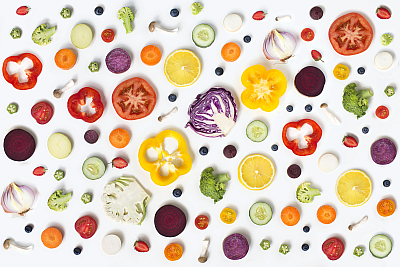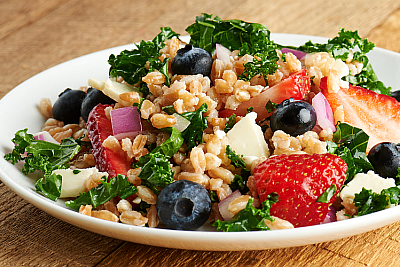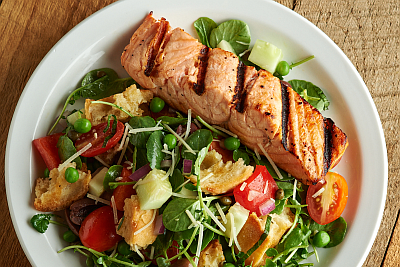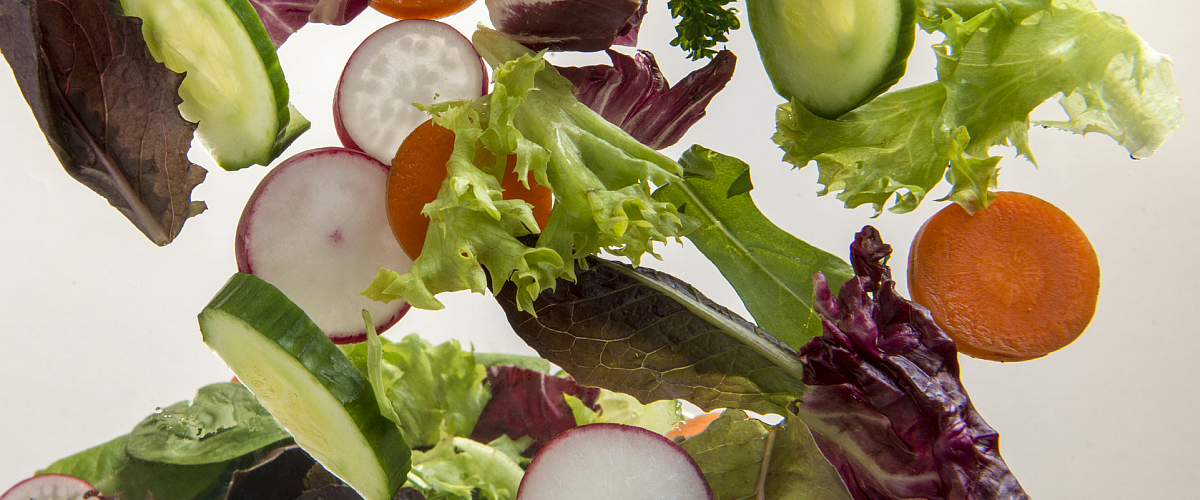Is it getting hot in here?! When temperatures are on the rise, nothing beats cooling off with crisp and refreshing eats. That’s one reason salads are a summertime staple.

But salads sometimes get a bad rap for being boring and bland—the consolation prize to a more satisfying meal that’s a go-to most often when you’re seeking to drop a few pounds.
If you feel this way about salads, then you might be in a salad rut. Here to pull you out of it are Aramark’s Chef Tom Ramsey and Registered Dietitian Nutritionist Mackenzie Proctor (photo), who work together at Drexel University in Philadelphia. They walk us through how to build scrumptious salads like a pro. Your summer meals will never be the same!
Build the Best Salad, Step by Step
“There’s no better time to up your salad game than summer,” says Chef Tom. “The endless combinations of in-season produce create layers of texture and flavor.”
Mackenzie agrees: “Salads can be both healthy and crave-worthy. Plus, they are super easy to prepare. It just takes a little planning.”
Step 1: Get Going with Greens
We’re all about that base, and most salads are built upon a lush bed of greens. Opt for dark leafy greens, as they offer more nutrition than lighter varieties (Remember the color-nutrition connection?) “I find that darker greens provide more substance and flavor than romaine or iceberg lettuce,” Chef Tom says.
It’s okay to be generous here, Mackenzie points out. “Greens add lots of volume to your salad with very few calories.” Here’s a guide to some of their favorites:
- Kale: You’d be hard-pressed to find a more nutrient-dense green than kale. It is brimming with fiber, calcium, and vitamin K – to name a few. If the texture is too tough, try massaging the raw leaves with a touch of olive oil first.
- Spinach: Popeye’s go-to green offers potassium, vitamin A, and folate. Its mild flavor marries well with a range of toppings and dressings.
- Arugula: If you gravitate toward spice, try this peppery green that packs even more calcium than kale and is a great source of antioxidants and fiber.
Step 2: Vary Your Veggies

What’s a salad without tons of fresh vegetables? Here, new techniques can bring an unexpected twist. Try roasting, marinating, or pickling in-season veggies like bell peppers, zucchini, and tomatoes.
Chef Tom is also a fan of fermentation, a natural process for preserving foods that lends an unmistakable tang. “Pickled onions and fermented garlic go great in salads,” he suggests.
But fermentation is about more than flavor, Mackenzie explains: “Fermented foods contain healthy bacteria to boost your gut health, which helps with digestion and a strong immune system.” While fermented foods seem to be just about everywhere, it’s important to consume this type of food in a mindful way. Learn a bit more about the benefits (and a recipe you can make right at home!) before you go all in.
Also, shoot to feature at least three different colored vegetables in your salad. The more colorful a salad, the more nutrients you’ll be getting.
Step 3: Focus on Fruit

Fruit is your friend when it comes to balancing out some of these savory flavors. Trade in your winter pears and pomegranates for summertime produce like nectarines and watermelon, which we love to serve with feta and red onion. Or throw some peaches on the grill. The smoky flavor will pair well with pecorino or a tart, soft cheese like goat.
Chef Tom often turns to berries for a touch of sweetness: “A handful of blueberries or strawberries brings brightness to a salad — not only with flavor, but color as well.”
Fruit can pull double duty in a salad, Mackenzie notes, as their juices help you cut back on dressing. (More on that later!)
Step 4: Pick Your Protein
Next time you’re shopping for salad ingredients, grab a source of protein. “Whether you go with plant-based or animal-based, that protein will make your salad creation heartier and more filling,” says Mackenzie.
- Plant-Based: We’re fond of quinoa because it’s considered a complete protein! It also packs in fiber, iron, and magnesium. Other great protein options include lentils, chickpeas, toasted nuts, and hemp seeds.

- Animal-Based: Lately we’ve been hooked on protein from under the sea! Mild-tasting seafood plays well with strong fruity or savory flavors. Top your salad with three or four grilled shrimp for about 18 grams of lean protein and some heart-healthy omega-3 fatty acids. “If shrimp isn’t your thing, try crowning your salad with salmon, chicken, a hard-boiled egg, or a sprinkle of cheese,” Chef Tom suggests.
Crisp fruits and veggies can get the texture party started, but in our opinion there’s always room for more crunch. For some inspiration, check out our new Grilled Salmon & Panzanella Salad recipe, which combines crispy croutons with juicy tomatoes and crunchy cucumbers for a delicious assortment of textures.
Croutons are a classic choice but by no means the only option. “Crunch makes a salad fun to eat. Think about a handful of sliced almonds, roasted edamame, or pumpkin seeds,” advises Chef Tom.
Step 5: Dress It Up
Dressing can make or break a salad. Too little and you miss out on flavor; too much and you’ve got a soggy mess. But not all dressings are created equal, especially when it comes to nutrition.
“Dressings pack a ton of calories, so less is more. Reach for oil-based vinaigrettes rather than cream-based,” Mackenzie recommends. “The healthy fats from olive oil actually help your body absorb the nutrients from your salad more efficiently.” Once you have your healthy oil of choice, mix in honey, herbs, spices, or even a small amount of nut butter to concoct your homemade dressing.
Another salad hack is to add a soft-boiled egg; the still-creamy yolk will add a dreamy consistency. “Simmering the egg for 90 seconds to 2 minutes is all it takes,” instructs Chef Tom.
Dressing is perhaps the most personal of salad decisions, so keep on experimenting to suit your tastes —and take your salad from average to awesome.
Salads Reign Supreme
Whether your canvas is a plate or bowl, reusable plastic container or mason jar, salads are an especially handy way to savor all of your delicious summer produce. They are also a natural choice to help you eat plant-forward, which is a boon to both your health and the environment.
Check out our recent local produce blog for more inspiring tips from a few of our chefs!
Note: Since everyone’s health history and nutritional needs are so different, please make sure that you talk with your doctor and a registered dietitian to get advice about the diet and exercise plan that‘s right for you.

